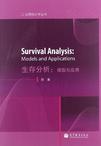生存分析
出版时间:2012-7 出版社:高等教育出版社 作者:刘宪 著 页数:446
Tag标签:无
内容概要
《应用统计学丛书·生存分析:模型与应用
(英文版)》旨在系统地介绍生存分析的基本概念、理论设定和方法运用,重点在于通过SAS统计软件对实际数据进行分析,深入浅出地描述生存分析的各类模型。书中涉及的统计方法包括Kaplan-Meirer估算法、各类参数回归模型、Cox等比发生率模型、多向发生率模型和重复发生率模型、结构性风险率模型以及一些生存分析方面的专题研究方法。
《应用统计学丛书·生存分析:模型与应用
(英文版)》着重于各类生存分析模型的实际运用,而不拘泥于模型的纯理论推导,从而使对生存分析有兴趣的科研人员以及大学生、研究生从中受益。
作者简介
刘宪,1991年5月获密歇根大学社会学博士学位,现任美国国防医科大学(Uniformed Services
University of the Health
Sciences)精神病学系高级研究员、副教授及美国沃尔特里德国家军事医学中心(Walter Reed Army Medical
Center)研究员、高级统计师。在国际顶级刊物发表学术论文数十篇。截至2012年3月,所发表学术论文在国际各类刊物被引用1000多次。刘宪博士的主要研究领域为生存分析与死亡率交叉研究、纵向资料分析、创伤事件与精神疾病。
书籍目录
Preface
1 Introduction
1.1 What is survival analysis and how is it applied?
1.2 The history of survival analysis and its progress
1.3 General features of survival data structure
1.4 Censoring
1.4.1 Mechanisms of right censoring
1.4.2 Left censoring, interval censoring, and left truncation
1.5 Time scale and the origin of time
1.5.1 Observational studies
1.5.2 Biomedical studies
1.5.3 Health care utilization
1.6 Basic lifetime functions
1.6.1 Continuous lifetime functions
1.6.2 Discrete lifetime functions
1.6.3 Basic likelihood functions for right, left, and interval
censoring
1.7 Organization of the book and data used for illustrations
1.8 Criteria for performing survival analysis
2 Descriptive approaches of survival analysis
2.1 The Kaplan-Meier (product-limit) and Nelson-Aalen
estimators
2.1.1 Kaplan-Meier estimating procedures with or without
censoring
2.1.2 Formulation of the Kaplan-Meier and Nelson-Aalen
estimators
2.1.3 Variance and standard error of the survival function
2.1.4 Confidence intervals and confidence bands of the survival
function
2.2 Life table methods
2.2.1 Life table indicators
2.2.2 Multistate life tables
2.2.3 Illustration: Life table estimates for older Americans
2.3 Group comparison of survival functions
2.3.1 Logrank test for survival curves of two groups
2.3.2 The Wilcoxon rank sum test on survival curves of two
groups
2.3.3 Comparison of survival functions for more than two
groups
2.3.4 Illustration: Comparison of survival curves between married
and unmarried persons
2.4 Summar
3 Some popular survival distribution functions
3.1 Exponential survival distribution
3.2 The Weibull distribution and extreme value theory
3.2.1 Basic specifications of the Weibull distribution
3.2.2 The extreme value distribution
3.3 Gamma distribution
3.4 Lognormal distribution
3.5 Log-logistic distribution
3.6 Gompertz distribution and Gompertz-type hazard models
3.7 Hypergeometric distribution
3.8 Other distributions
3.9 Summary
4 Parametric regression models of survival analysis
4.1 General specifications and inferences of parametric regression
models
4.1.1 Specifications of parametric regression models on the hazard
function
4.1.2 Specifications of accelerated failure time regression
models
4.1.3 Inferences of parametric regression models and likelihood
functions
4.1.4 Procedures of maximization and hypothesis testing on ML
estimates
4.2 Exponential regression models
4.2.1 Exponential regression model on the hazard function
4.2.2 Exponential accelerated failure time regression model
4.2.3 Illustration: Exponential regression model on marital status
and survival among older Americans
4.3 Weibull regression models
4.3.1 Weibull hazard regression model
4.3.2 Weibull accelerated failure time regression model
4.3.3 Conversion of Weibull proportional hazard and AFI'
parameters
4.3.4 Illustration: A Weibull regression model on marital status
and survival among older Americans
4.4 Log-Iogistic regression models
4.4.1 Specifications of the log-logistic AFI' regression
model
4.4.2 Retransformation of AFT parameters to untransformed
log-logistic parameters
4.4.3 Illustration: The log-logistic regression model on mar:ital
status and survival among the oldest old Americans
4.5 Other parametric regression models
4.5.1 The lognormal regression model
4.5.2 Gamma distributed regression models
4.6 Parametric regression models with interval censoring
4.6.1 Inference of parametric regression models with interval
censoring
4.6.2 Illustration: A parametric survival model with independent
interval censoring
4.7 Summary
5 The Cox proportional hazard regression model and advances
5.1 The Cox semi-parametric hazard model
……
6 Counting processes and diagnostics of the Cox model
7 Competing risks models and repeated events
8 Structural hazard rate regression models
9 Special topics
Appendix A The delta method
章节摘录
版权页: 插图: Another popular graphical method for checking the proportional hazards assumption in the Cox model is using the Arjas(1988)plots.Specifically,the Arjas plots are designed to make direct comparisons between observed and estimated event frequencies without adding a time-dependent variable.Therefore,this method is not based on the estimation of alternative models and only involves parameter estimates already derived from the partial likelihood procedure. According to Arjas(1988),the application of the stratified Cox model is subject to two types of defects:(1)an influential covariate may be deleted from the model(this defect has been discussed in Section 5.5 of this book)and(2)the stratified Cox model is based on the assumption of a common baseline hazard for all individuals,so that the individuals are stratified according to the baseline hazard.These two defects can seriously influence the efficiency of the Cox model,thus making it difficult to perform a graphical check correctly on the validity of the proportionality hypothesis.Accordingly,he proposes to test the pro-portionality assumption directly from the proportional hazard model including all(M+1)covariates. Practically,deriving the Arjas plots can be performed by taking the following steps.First,divide n individuals into K strata of the(M+1)th covariate according to the research interest of a particular study or previous findings.If the(M+1)th covariate is a continuous variable,classify the sample respondents into a few categories according to an existing theory or results from a previous empirical analysis.Second,calculate the estimated cumulative hazard rate at each observed survival time for each stratum using the parameter estimates obtained from the Cox model.Third,compute the cumulative number of actual events at each survival time for each stratum.Fourth,plot the estimated cumulative hazard rate at each actual survival time along the y axis against the corresponding observed cumulative number of events on the x axis for each stratum.Eventually,discrepancies between the estimated cumulative hazard rate and the empirical data can display whether the estimated hazard rates of those stata are scattered randomly or systematically too high or too low.
编辑推荐
《生存分析:模型与应用(英文)》是由刘宪著,高等教育出版社出版的。《生存分析:模型与应用(英文)》着重于各类生存分析模型的实际运用,而不拘泥于模型的纯理论推导,从而使对生存分析有兴趣的科研人员以及大学生、研究生从中受益。
图书封面
图书标签Tags
无
评论、评分、阅读与下载
用户评论 (总计1条)
- 英文的,不过看起来还行。入门还不错。
推荐图书
- 内燃机工作过程仿真技术
- 陌生化翻译
- 青藏高原碉楼研究
- 神秘事件调查员真实口述2灵血宝箱
- 区域文化与文学研究集刊(第2辑)
- 对抗卷-十二星座搞怪生
- 数控机床故障诊断与维护
- 唐宋诗风流别史
- 挑战爱的审判日
- 文化生态与20世纪中国文学理论批评的发展演变
- 我国国有企业人本管理研究
- 现代工程制图
- 现代工程制图习题集
- 宪政视野下我国中央与地方财政关系研究
- 信息传媒文化与当代文艺生产消费的新变
- 行政法中的不确定法律概念研究
- 玄学与理学的学术思想理路研究
- 阳都集
- 阴山岩画研究
- 永平之风
- 杂譬喻经注译与辨析
- 这样说话你的气场才够强大
- 章学诚史学哲学研究
- 政治文明视阈下舆论监督法治建设研究
- 中国共产党人的马克思主义观
